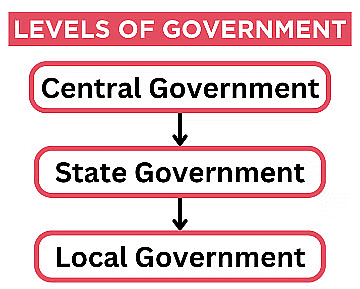Chapter 10 Grassroots Democracy Part 1 Governance Notes & Summary
November 5, 2024Chapter 12 Grassroots Democracy Part 3 Local Government in Urban Areas Notes & Summary
November 5, 2024Introduction
India is a vast and diverse country with about 600,000 villages, 8,000 towns, and over 4,000 cities. Nearly two-thirds of India’s population lives in rural areas. To govern such a complex society, India has a unique system of local governance known as the Panchayati Raj system. This system ensures that governance reaches the grassroots level, empowering people to participate actively in their own development. Let’s take a journey to Lakshmanpur, a small village in the foothills of the Himalayas, to understand how this system works.

The Panchayati Raj System
The Panchayati Raj system is a decentralized form of government where local people elect their representatives to manage local affairs. It works at three levels: the village, the block, and the district, forming a three-tier system.
Levels of Panchayati Raj
- Gram Panchayat (Village Level): This is the basic unit of local governance. The Gram Panchayat consists of members elected by the Gram Sabha, which includes all adult residents of the village. The head of the Gram Panchayat is called the Sarpanch or Pradhan.
- Panchayat Samiti (Block Level): This is the intermediate level that coordinates between the Gram Panchayats and the Zila Parishad. It manages a group of villages within a block.
- Zila Parishad (District Level): This is the highest level of the Panchayati Raj system, overseeing all the blocks within a district. It ensures that development plans from various Panchayat Samitis are implemented effectively.

Functions of the Gram Panchayat
The Gram Panchayat is the closest to the people and handles various local issues. Here are its key functions:
- Infrastructure Maintenance: Building and repairing roads, maintaining water supply systems, and ensuring sanitation.
- Education: Overseeing local schools, ensuring children attend school, and implementing educational schemes.
- Healthcare: Organizing health camps, ensuring the availability of clean drinking water, and promoting hygiene.
- Agriculture: Supporting farmers with information on best practices, organizing irrigation, and implementing agricultural schemes.
- Social Welfare: Addressing issues like poverty, child labor, and women’s empowerment through various programs.

Try yourself:
What is the highest level of the Panchayati Raj system?
A.
Gram Panchayat
B.
Panchayat Samiti
C.
Zila Parishad
Correct Answer
D.
State Government
Explanation
– The Zila Parishad is the highest level of the Panchayati Raj system, overseeing all the blocks within a district.
Report a problem
Exemplary Sarpanchs
The role of a Sarpanch is crucial in driving development and addressing issues. Here are a few inspiring examples:
- Dnyaneshwar Kamble: A transgender Sarpanch in Maharashtra who promotes community service with the motto “lok seva, gram seva” (service to the village is service to the public).
- Vandana Bahadur Maida: The first female Sarpanch from her village in Madhya Pradesh, who championed education and sanitation.
- Popatrao Baguji Pawar: Sarpanch of Hiware Bazar in Maharashtra, transformed his drought-prone village into a green and prosperous community through rainwater harvesting and tree planting.
Child-Friendly Panchayat Initiative
The Child-Friendly Panchayat Initiative ensures that children’s voices are heard in village governance. Children participate in Bal Sabhas and Bal Panchayats to discuss and address issues affecting them, such as education and child labor.

Example: In Sikkim, the Sangkhu Radhu Khandu Gram Panchayat built school compound walls and kitchens for midday meals, earning the title of a child-friendly Gram Panchayat.
Panchayat Samiti and Zila Parishad
These institutions exist at the block and district levels, respectively, to link village-level governance with broader district administration.
- Panchayat Samiti: Collects and coordinates development plans from Gram Panchayats and presents them at the district level for fund allocation and implementation.
- Zila Parishad: Oversees the execution of development projects across the district, ensuring that government schemes reach the grassroots.
Fun Fact: The Panchayati Raj system reserves one-third of its seats for women, promoting gender equality in local governance.
Importance of Panchayati Raj Institutions
Panchayati Raj institutions are vital for several reasons:
- Empowerment: They empower local communities to make decisions about their own development.
- Efficiency: Local governance is more efficient as it directly addresses the needs and problems of the community.
- Participation: Encourages active participation from all sections of society, including women and marginalized groups.

Fun Fact
Historical Insight: The Arthaśhāstra, an ancient Indian text by Kauṭilya (Chanakya), described a similar hierarchical governance structure over 2,300 years ago, emphasizing the importance of local administration.
Try yourself:
Which institution ensures that children’s voices are heard in village governance?
A.
Panchayat Samiti
B.
Zila Parishad
C.
Bal Sabhas
Correct Answer
D.
Gram Panchayat
Explanation
– Bal Sabhas ensure that children’s voices are heard in village governance by allowing them to discuss and address issues affecting them.
– Children participate in Bal Sabhas to advocate for their rights, such as education and protection against child labor.
Report a problem
Conclusion
The Panchayati Raj system is a cornerstone of Indian democracy, ensuring that even the most remote villages have a voice in governance. By understanding and participating in this system, villagers can directly influence their development and improve their quality of life. This decentralized approach not only strengthens democracy but also fosters a sense of community and collective responsibility.

